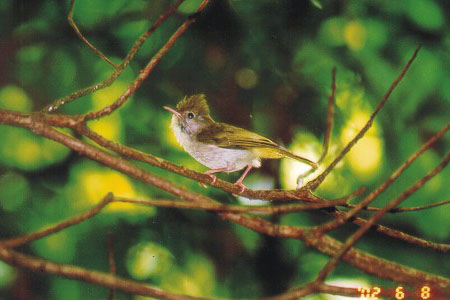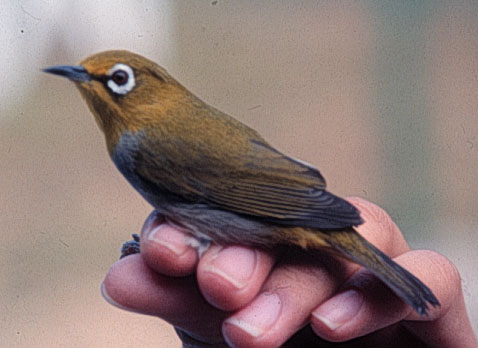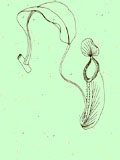
 |
Vertebrates (pdf)
Trouble with babblers: the White-bellied Yuhina is neither a yuhina nor a babbler, but the Japanese White-eye is both
Alice Cibois has devoted most of her short career to sorting out the phylogeny of the babblers – a group traditionally defined to include mostly Asian, mostly forest, mostly more or less insectivorous birds. The traditional babblers are extremely diverse in morphology, ecology and behaviour, and it has been obvious for a long time that the conventional classification of the 200 or so species was a mess. Exactly how much of a mess is being revealed one paper at a time (Cibois et al., 1999, 2001, 2002; Cibois, 2003). The revelations are by no means complete, but two recent papers are relevant to Hong Kong birds. The first shows, using mitochondrial sequence data, that the White-bellied Yuhina (Yuhina zantholeuca) (Fig. 1) is not related to the other yuhinas – which it doesn’t look like anyway - or even the other babblers (Cibois et al., 2002). The second shows, using sequences of three mitochondrial genes, that the Japanese White-eye (Zosterops japonica) (Fig. 2) is not only a babbler, but is also closely related to the two yuhinas included in the analysis (Y. gularis and Y. diademata) (Cibois, 2003). Although only one white-eye was included, the other Zosterops species are so similar they (but not necessarily the rest of the family) must all belong with the babblers. This study also – less surprisingly – placed the Sylvia warblers firmly within the babblers, as well as the American Wrentit (Chamaea fasciata) (for which, see also Barhoum & Burns, 2002). The laughingthrushes are not only back among the babblers (from which they had been separated by Sibley and Monroe), but also not monophyletic. The Chinese Babax (Babax lanceolatus) appears to be part of a group containing the White-browed Laughingthrush (Garrulax sannio). With all these inclusions, the expanded babblers now range throughout Africa and Eurasia to Australia, New Zealand and the Pacific, with the Wrentit as an outlier in North America.
 |
| Fig. 1 "The White-bellied Yuhina" is neither a yuhina nor a babbler. (Photo: Kwok Hon Kai) |
Bibliography
Barhoum, D.N. & Burns. K.J. (2002). Phylogenetic relationships of the wrentit based on mitochondrial cytochrome b sequences. Condor 104: 740-749.
Cibois, A. (2003). Mitochondrial DNA phylogeny of babblers (Timaliidae). Auk 120: 35-54.
Cibois, A., Slikas, B., Schulenberg, T.S. & Pasquet E. (2001). An endemic radiation of Malagasy songbirds is revealed by mitochondrial DNA sequence data. Evolution 55: in press.
Cibois, A., Pasquet, E. & Schulenberg, T.S. (1999). Molecular systematics of the Malagasy babblers (Passeriformes: Timaliidae) and Warblers (Passeriformes: Sylviidae), based on cytochrome b and 16S rRNA sequences. Molecular Phylogenetics and Evolution 13: 581-595.
Cibois, A., Kalyakin, M.V., Han, L.X. & Pasquet, E. (2002). Molecular phylogenetics of babblers (Timaliidae): revaluation of the genera Yuhina and Stachyris. Journal of Avian Biology 33 :380-390.
 |
|
Fig. 2. The Japanese White-eye is a babbler. |
|
|
P.9-11 |
|
Porcupine! |
 Copyright © 2000 |
